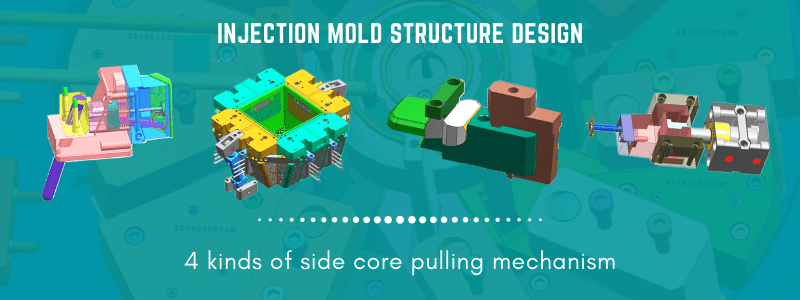
The side core-pulling mechanism is used to solve the complicated mechanism of plastic parts. There are many types of side core-pulling mechanisms, and there are various classification methods. This article refers to four types of side core-pulling mechanisms. Divided into the following four types of injection mold structure design.
1. side core pulling mechanism of inner slide.
2. Slanted top and swing bar mechanism.
3. Hydraulic side core-pulling mechanism.
4. Half mold mechanism.
Let’s dive in.
Injection mold structure design: inner slider mechanism.
The inner slider mechanism is mainly used for molding the inner wall side concave or convex. When the mold is opened, the slider moves toward the “center” of the plastic part. Its typical structure is as follows.
Inner slider mechanism-1.
As shown in Figure 1. The angle pin 3 drives the inner slider 1 to move. Complete the parting of the concave side wall of the plastic part. After the angle pin 3 is separated from the inner slider 1, the inner slider 1 is positioned by the spring 4. Due to the need to machine oblique holes on the inner slide 1. The width of the inner slider is required to be large.
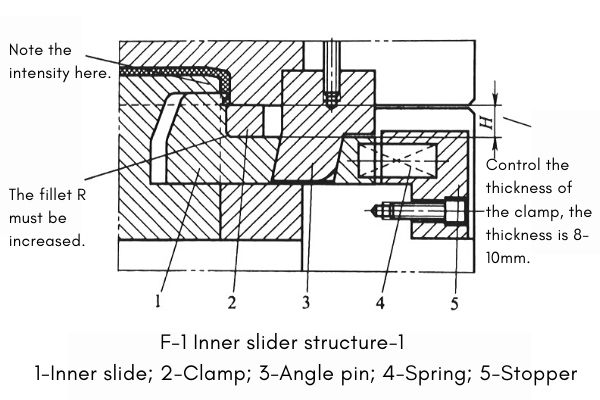
Inner slider mechanism-2.
as the picture shows. The oblique tail is directly machined on the inner slider 1. During the mold opening, the inner slider 1 is driven by the inclined surface A of the insert 5. Completed the inner wall side concave molding. This form is compact and takes up little space. And the width of the inner slider is not stopper.
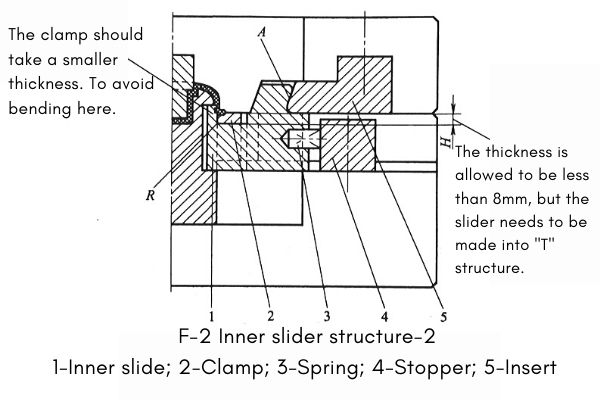
Inner slider mechanism-3.
As shown in Figure 3. In order to prevent the plastic part from being ejected, the movable mold scrapes the convex part. Requires icon size D> 0.5mm, a1> a.
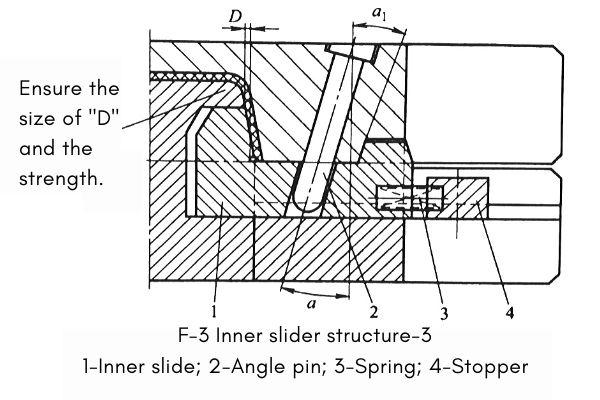
Injection mold structure design: lifter and swing bar mechanism.
The lifter and oscillating bar mechanism is used to concave and convex inside the plastic parts. And has the eject function. The structure of the mechanism is simple, but the rigidity is poor and the stroke is small.
Mold lifter Mechanism
Figure F-4 is the most basic mold lifter mechanism. Under the action of the ejection force, the lifter 1 moves along the inclined square hole of the mold to complete the side molding.
In order to ensure the stability and reliability of the lifter work, the following points should be noted.
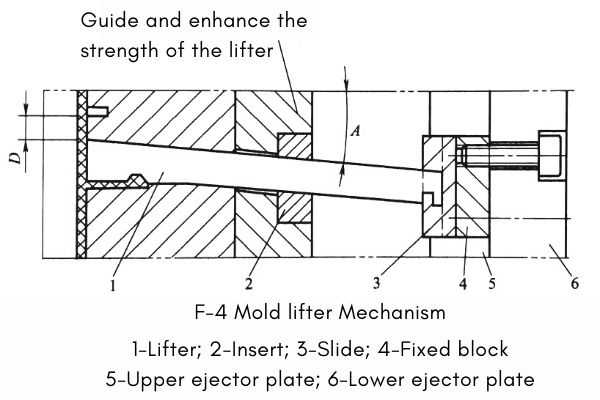
1. Ensure the rigidity of the mold lifter.
(1) If the structure allows, please increase the cross-sectional size of the lifter.
(2) When the ejection is satisfied, reduce the angle “A” of the lifter. The bevel angle A cannot be greater than 15 °. Generally around 8 °. And move the lateral stress point of the inclined top downward. Add insert 2 as shown in Figure F-4. Inserts need to have higher hardness to increase the life of the mold.
2. To ensure the horizontal movement space of the lifter.
As shown in Figure F-4 size “D”. In order to ensure that the lifter does not interfere with other structures on the plastic part when it is ejected. The lateral parting distance and the angle “A” of the lifter should be fully considered. To ensure that there is enough space for lateral movement.
3. Reset of the lifter in the mold opening direction.
In order to ensure that after closing the mold, the lifter returns to the predetermined position. Use the structure shown in Figure F-5.
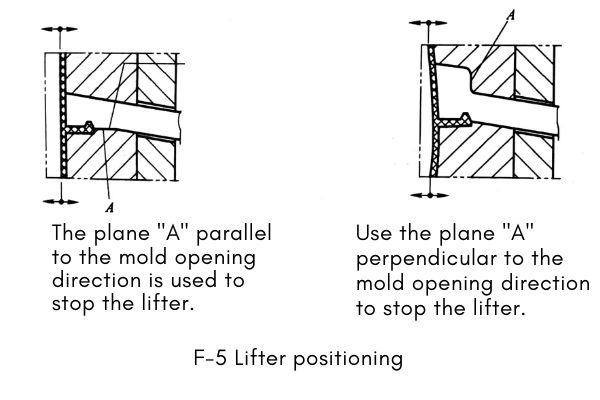
4. The lifter moves smoothly.
Make sure that the bottom of the lifter runs smoothly on the thimble plate. There must be no blockage, otherwise the mold will be damaged.
Split type lifter.
When the length of the lifter is long, the cross-sectional size is small, or the inclination angle is large, the split type lifter can be used. This can increase the rigidity and strength of the lifter. According to the different reset methods, it can be divided into 3 structures.
Split type lifter structure -1.
In the figure below, the lifter can be enlarged to the outside of the plastic part. Increase outward by 5 ~ 8mm, which not only increases the strength, lifter also can be accurately reset. Add stopper block to ensure that H3 = H1-0.5, L≈2d.
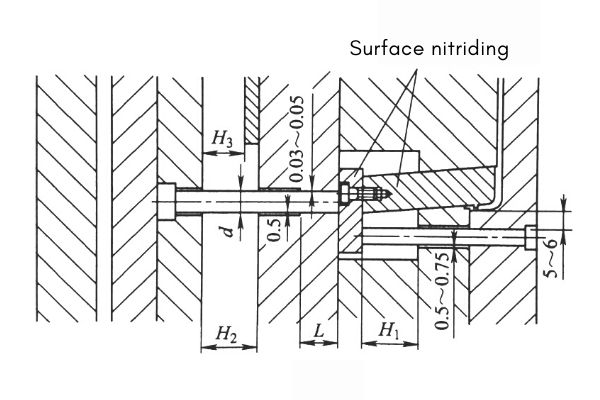
Split type lifter structure -2.
As shown below. Add a putter on the other side of the lifter. When closing the mold, push the lifter back to its position. The surface of the lifter and the lower pad should be enhance wear resistance. Other size changes: H = H10.5, L≈2d.
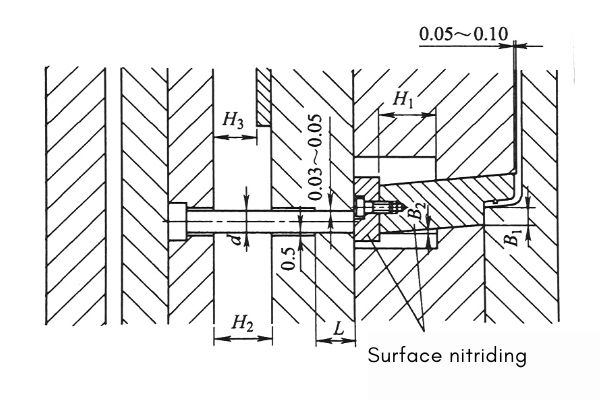
Split type lifter structure -3.
As shown below. This kind of inclined top is simple to make, and it is suitable for occasions with long lifter.
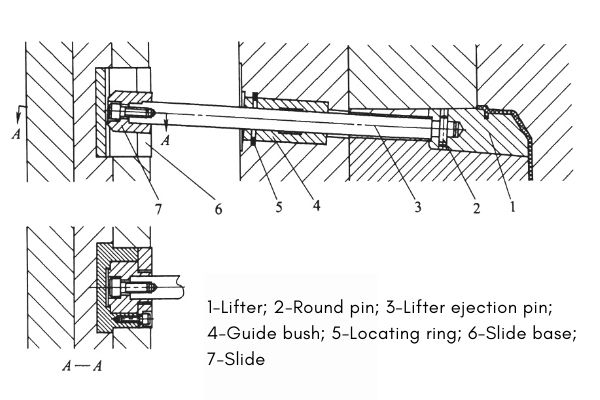
Fixed mould lifter structure.
The fixed mold lifter is used when the fixed mold has undercut. The principle and calculation method of the stroke are the same as that of the movable mold lifter. There are two common structures.
Fixed mould lifter structure -1.
There is a kiss off hole next to the undercut, you can use the movable mold insert to push the lifter reset. As shown in the figure below, this is a relatively simple structure. The lifter slides out under the action of the spring. In the picture, the k/o surface S is more than 100mm². The slope a of the lifter should not exceed 25 °.
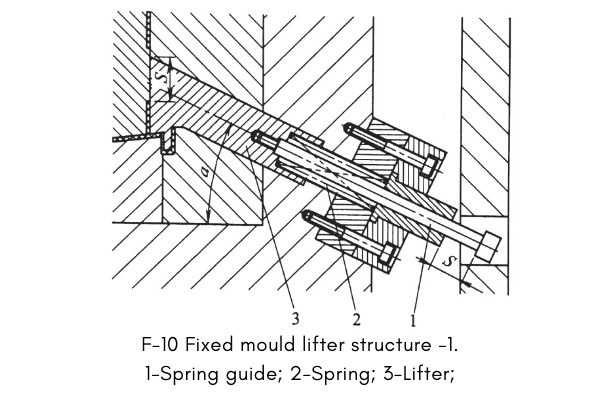
Fixed mould lifter structure -2.
When there is no K/O holes next to the undercut, the lifter must be reset by the putter. The lifter structure shown in the figure below can be used. This design is the same as movable mold lifter.But the power comes from the clamping force of plastic parts to the lifter and spring.
The lifter also needs to add guide pin and guide bush. The maximum slope a≤15 of the lifter , the friction surface of the lifter is nitriding. The lifter can also be designed in two split as required.
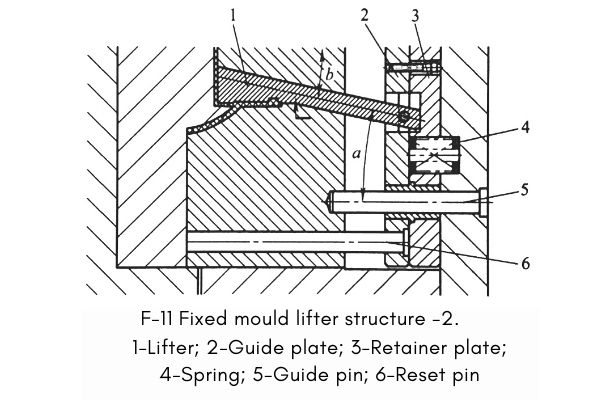
Swing bar basic mechanism.
as the picture shows. During the ejection process, when the head of the swing bar 1 (the range indicated by L1) exceeds the moving model core. The swing rod 1 swings upward under the action of the inclined plane A to complete the parting.
When designing the swing mechanism, it should be ensured that: L2> L1; E2> E1.
Disadvantages: Figure “B” is easy to wear, and the hardness needs to be increased here. It is generally required to design this place as a mosaic structure.
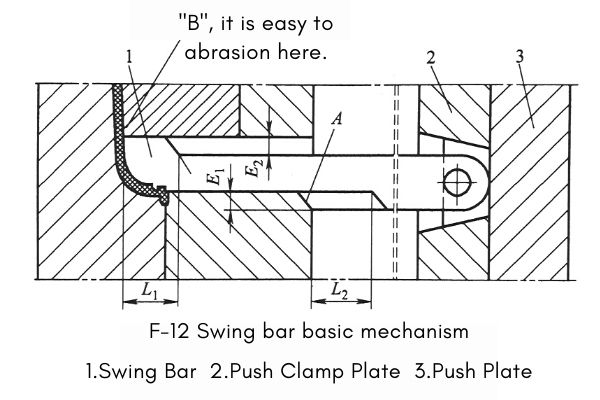
Injection mold structure design: Hydraulic cylinders core pulling mechanism.
Hydraulic cylinders are widely used in the mold industry. When the buckle stroke is greater than 45mm, we will choose the hydraulic cylinders core pulling.
Characteristics of hydraulic core pulling mechanism:
1. The slider has a long stroke and a large core pulling force.
2. The parting and core pulling are not restricted by mold opening time and ejection time.
3. The movement is smooth and flexible.
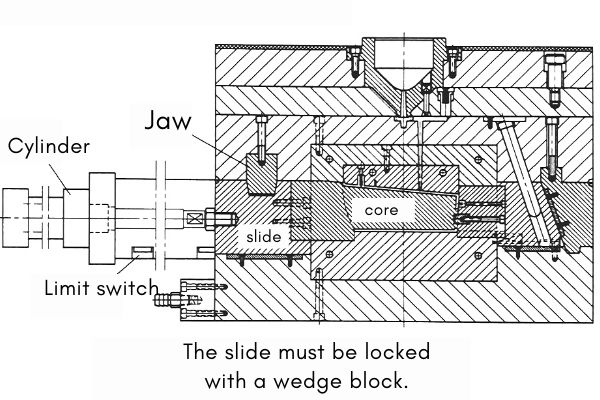
Design Points.
1.The cylinder has no rigid clamping force. It is forbidden to use hydraulic cylinder to clamp the mold. Unless the slider is not affected by the expansion force in the sliding direction. Otherwise, wedges must be designed.
2.Prevent the slider from interfering with the movable and fixed mold.
3.Prevent the hydraulic cylinder from interfering with the injection molding machine.
4.Support seats must be designed for fixed hydraulic cylinders. And do positioning for the support base.
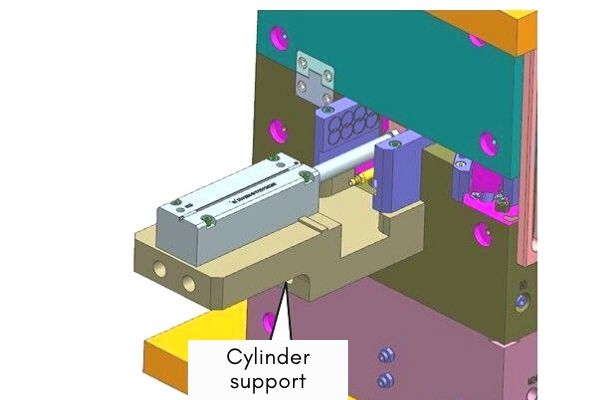
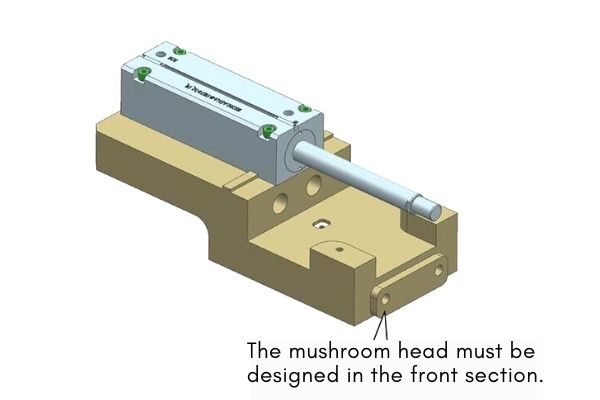
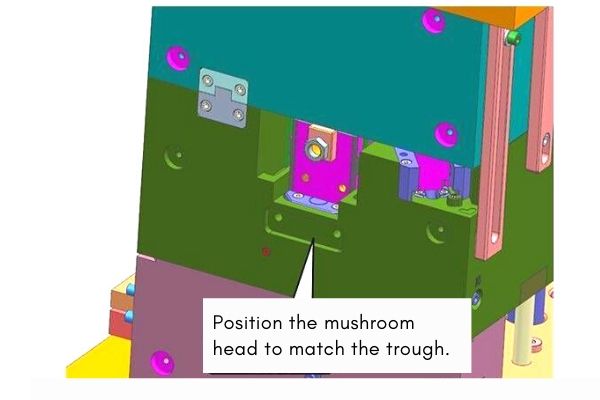
5.T insert connection can be used to connect with the slider base.
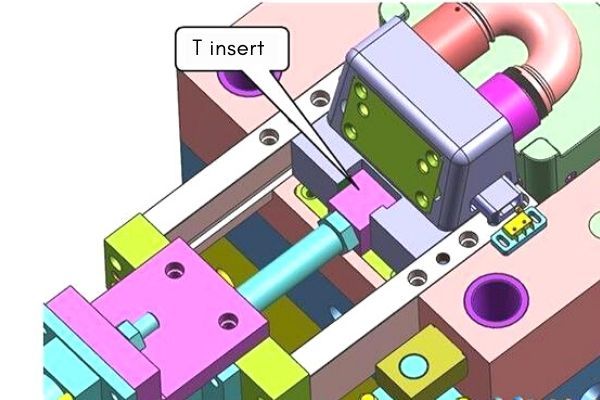
6.Mold spacer block must be designed when the oil cylinder is installed on the ground to prevent the oil cylinder from being damaged.
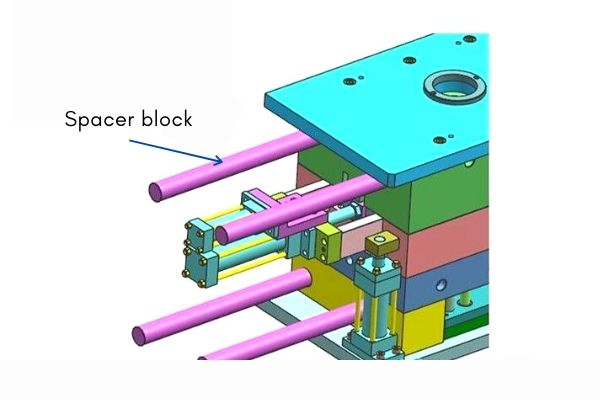
Injection mold structure design: Half mold design.
Two or more sliders are combined to form a cavity. When the mold is opened, the side core-pulling mechanism that the slider simultaneously realizes the side parting is called the half mold. The side pulling stroke of the half mold is generally small. The structure of the Half mold is as follows.
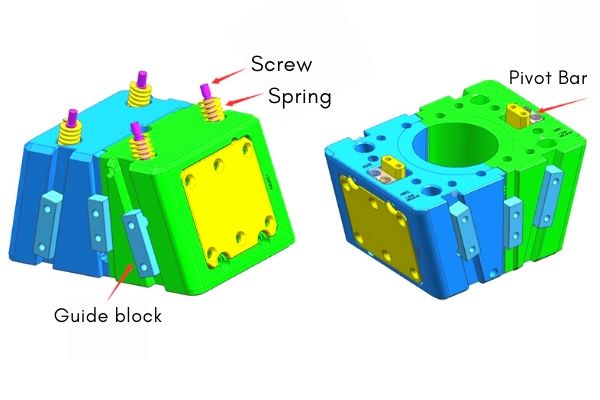
Half mold structure-1.
As shown in the figure below, the cavity is composed of two inclined slides located on one side of the fixed mold. When the mold is opened, under the action of the pull hook 1 and the spring, the inclined slider 3 runs along the inclined chute to complete the lateral parting. After splitting, the inclined slider 3 is positioned by the spring 2 and the stopper block 4.
The structure and assembling form of the pivot bar 1 generally adopt two methods on the right side of the drawing. The oblique angle A of the inclined slider generally does not exceed 30 °.
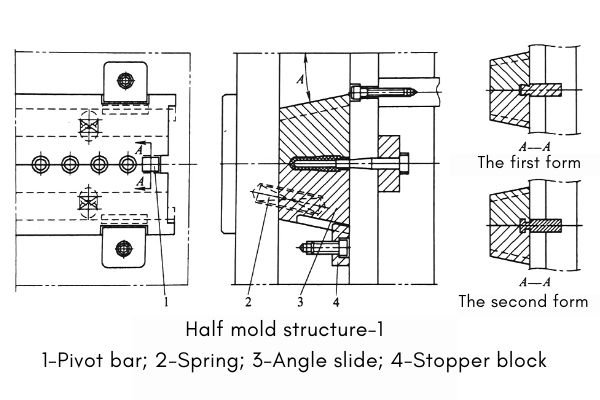
Half mold structure 2.
As shown in the figure, the cavity is composed of two inclined sliders on one side of the moving mold. During the ejection, the inclined slider 3 moves along the inclined slide groove under the action of the ejector rod 5 to complete the lateral parting and push out the plastic part at the same time.
The oblique angle A of the inclined slider generally does not exceed 30°.
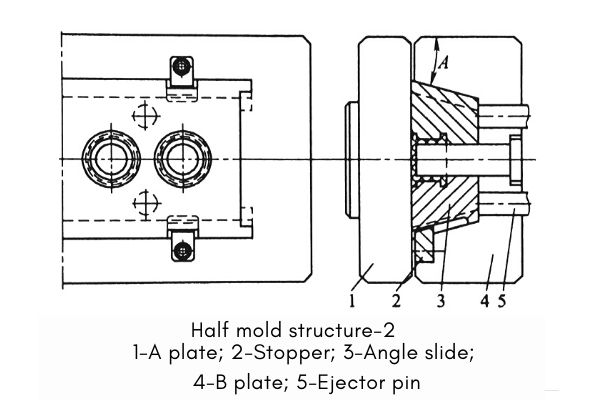
At the end.
The side core-pulling structure still has a lot to explore. There are also many delicate and innovative ideas. These are waiting for us to discover. The road of structural design of injection molds goes further and further.
If you have any questions, please contact us.
